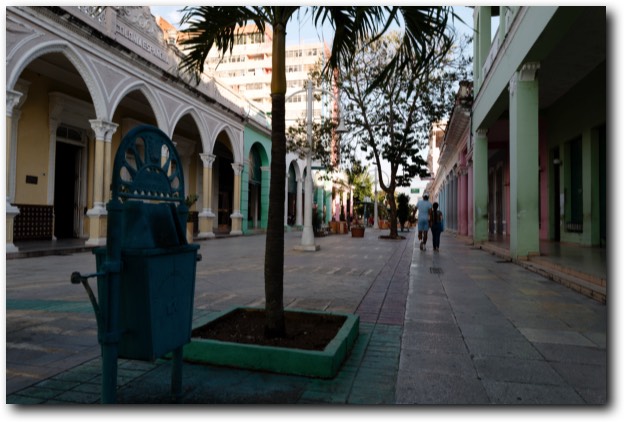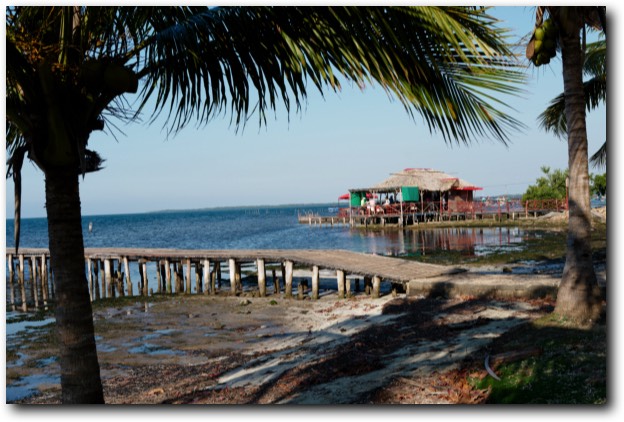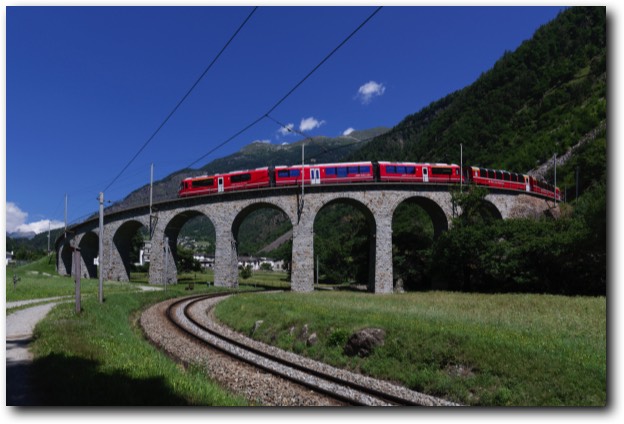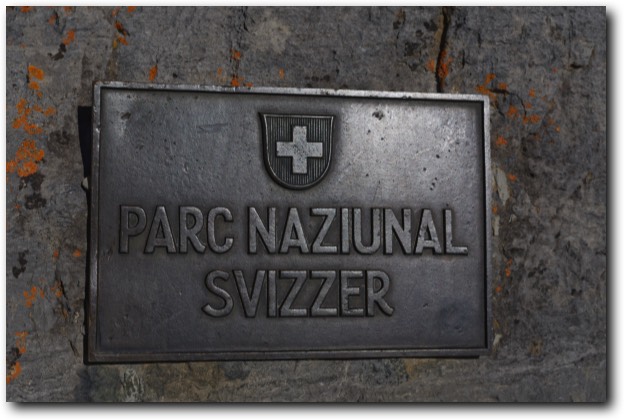
Cuba - the countryside, 2025
Much of the island is flat, but in places mountains rise up to 1,400 or even 1,900 metres. These are uninhabited, leaving plenty of room for local flora and fauna. Cuba is home to many endemic species. Several encounters with the rural population were a welcome opportunity to discover their way of cultivating the land, raising animals and making charcoal. Cars are a rarity in Cuba, and the horse is very much at home here. Natural caves allow the villagers to take shelter during the cyclones that regularly form in the Caribbean. There are several natural parks well worth a visit. Sugar cane production has lost its importance since sugar is produced from sugar beet in importing countries. There are still many remnants of the period when this industry was fully exploited.

Cuba - the cities, 2025
Of Cuba's total population of 11 million, around 3 million live in Havana (La Habana to the Cubans). The capital is a big, lively city with a centre full of small shops, an old town around the port and newer districts. Like other cities on the island, Havana exudes its Spanish colonial past, with beautiful buildings. Unfortunately, many are not maintained and their facades are crumbling. Among the other towns we visited, highlights included the ubiquitous arcades of Ciego de Avila, the peacefulness and harmony with nature of Viñales, the warm musical harmonies of Trinidad and the paintings on the façades of Cienfuegos.

Cuba - the sea, 2025
Cuba's coastline is well preserved. The rocks in the coastal regions are often of metamorphic and volcanic origin. Their sharp shape contrasts with the fine sandy beaches of some tourist destinations, such as Varadero, where the sea takes on that magnificent Caribbean blue colour. Diving into a transparent sea at 25°C is pure bliss. In Varadero, however, the presence of numerous hotels contrasts little with the areas inhabited by the original village.

Lechweg - a hike along the River Lech, 2024
A hike in the Austrian Tyrol, along the River Lech from its source to the waterfalls on the Bavarian border at Füssen.
This is one of the last wild river landscapes in Europe. A trail that follows the Lech for around 125 kilometres from its source near Lake Formarin in the Austrian state of Vorarlberg to the Lech Falls at Füssen in the Allgäu, on the German border, close to the famous Bavarian royal castles of Hohenschwangau and Neuschwanstein.
The route links three regions and two countries, each with its own traditions and history. From the Arlberg region to southern Allgäu, via the Tyrolean Lechtal Reutte nature park: the Lech has shaped these regions over the centuries. The river has played an important role in the history of trade routes. Numerous species of birds and wild orchids make up one of the most species-rich habitats in Central Europe. To preserve one of the last wild river landscapes in Europe, the Tyrolean Lech Nature Park was created.

India -2023 meeting people
It's very easy to get in touch with people. They spontaneously ask you to take photos with them, where you're from, where you're going and how old you are. It's surprising for Europeans who aren't used to these familiar approaches, but it's also pleasant because the conversation starts very quickly. At the same time, the smile is omnipresent. All you have to do is accompany your gaze with your smile and it will be returned in kind. Even if the discussions do not go very far into the intimacy of each person, this makes for pleasant and warm encounters.

Spiritual India 2023
Kartik Purnima
Purnima or Poonam is an auspicious day in Hinduism. Poornima is the full moon day and many important rituals and festivals takes place on full moon. It is celebrated as the birth anniversary of Vrinda, personification of Tulsi plant (sacred basilica, plant used for their healing properties against the stress). This day also marks the birthday of Matsya, the fish incarnation of Lord Vishnu. On this day of Kartik Purnima, taking a sacred bath at places of pilgrimage, known as ‘Kartik Snan’ at the time of sunrise and moonrise, is considered to be highly sacred. Lord Vishnu is worshipped with flowers, diyas and incense sticks. Devotees generally observe fast on this day and recite the Satyanarayan Vrat Katha after performing Rudrabhishek.

Egypte 2023
At the equinox, night gives way to light. In Egypt, this passage may be very faintly felt, yet the rebirth is here. The energy that is increasingly taking its place to revive what was dormant during the winter. A new passage through this mythical place under the influence of an alchemical gaze.

Via Valtellina - Graubünden, 2021
Graubünden and Vorarlberg have been importing Valtellina wine to Italy for centuries. One of the mule tracks leads from Valtellina, via Davos, to Montafon. This historic route is being brought back to life by the ViaValtellina, an attractive long-distance hiking trail. The ViaValtellina leads from Montafon to Tirano, along an old mule track used to transport Valtellina wine, over the Passo del Schlappiner Joch, Scaletta Pass and Bernina. From Klosters, through Davos, Zuos and Pontressina to Poschiavo, the route takes in a variety of urban and landscape features. Davos is a mountain town, quite different from the charm of picturesque villages. We're on the edge of the highly touristy Upper Engadine. Towards the end of the trek, the path joins the famous Bernina Alpine Railway.

Swiss National Park - Engadine, 2020
A multi-day loop from Scuol through the Swiss National Park, the Unis, Sesvenna, S-charl, Avigna, Müstair and upper Inn valleys, returning to Scuol. Breathtaking scenery. The typical villages of this Lower Engadine region are filled with history and decorated with sgraffiti. Unlike the mundane Upper Engadine, this is a quiet valley, away from the great flood of tourists.

Egypt 2020
This was a following of the magical journeys: As in the past, we visited the pyramids, the Sphinx, the hanging church Le-Moallaqa, and the Cairo Museum, this time with Patrick Burensteinas. If the places we traditionally visited don't change, the view on them changes with compagny of Patrick. They are full of history where the knowledge was teached and developed. They are also full of light that passes through the body directly to the heart. The mind falls silent to let an inner voice speak - a luminous voice, full of vibrations of unconditional love, resonating throughout the whole body.

Egypt 2019
Author of more than 30 books, Daniel Meurois guided us in the spirit of his first tome on the life of Jeshua and his passage through the temple of Heliopolis and the Great Pyramid. A spirituality impregnated in the stones several thousand years old. The torpor of these constructions is only apparent and with a little effort they open up and let us feel their frequency.

Along the Nile River 2018
The whole boat was booked for our trip with Lise Bourbeau. According to her world-famous "Listen to your body" method, she prepared a one-week programme for us, focused on « Renaissance » : exploring what we wanted to let die... to be reborn. A work on oneself surrounded by the calm that emanates from the river in harmony with the formidable and powerful energy of the Egyptian temples. Temple of Karnak, Valley of the Kings, Temple of Hatshepsut, Temple of Edu, Sanctuary of Kom Ombo, Temple of Philae, Temple of Luxor.

Egypt 2017
It was my first trip to Egypt with Don Ernesto Ortiz and the discovery of the magical places of the Giza plateau and the necropolis of Saqquarah. On a personal path to raise consciousness and connect the spirituality to the everyday in the light of a poetic and existential approach to the soul. Powerful vibrations reinforced by mantras and meditations in contact with the stones charged with history. Leaving in the Red Pyramid what you wanted to leave there and coming out of the womb to be reborn. The entry into the Great Pyramid before dawn under the light of the Moon on Wesak day was reinforced by the vibratory chanting in the heart of the pyramid. Unforgettable moments leaving a living imprint in the heart. A permanent flame that can be rekindled at any time.

Ladakh 2017
With the clarity of the landscape, the contrasts between the land and the sky stand out in all their power. The land finds its fertility through water and forms islands of greenery among the brown mountains. Between 3,000 and 5,600 metres above sea level, the air is dry and the humidity low. Staying with local people allows a perfect immersion in this world close to the sky. The Ladakhis put on their festive clothes, coloured and contrasting the colour of the earth, to attend the festivals organised by the Buddhist temples. Rituals to chase away evil spirits where each mask has its own meaning. The region close to Pakistan, with an unstable border, is sometimes a source of armed conflict. The discovery of the welcoming Muslim villages contrasts with any spirit of hostility.

Haridwar, India 2016
Haridwar is one of the seven sacred cities of Hinduism in northern India, where the Ganges River leaves the mountains. The city is a very important place of pilgrimage, because according to tradition, the devotee who bathes in the Ganges at Haridwar has his sins erased and escapes the cycle of rebirths in the world of forms. Every day of the year, at nightfall, tens of thousands of people gather to attend the ritual to celebrate the Ganges. It was an introspective stay in the Santosh Puri ashram on the banks of the Ganges with some visits to Rishikesh. Christmas time spent differently.

Madagascar 2015
According to the local adage, God gave the Swiss a watch and the Malagasy time. It's true, people take their time, wait for the taxi-brousse at the side of the road without worrying about the schedule and, moreover, keep their smile. It is a red earth country, with high plateaus, rice fields and lemurs in the forests, often forming national parks. The population knows the medical benefits of the island's wild plants and uses them extensively. The link between man and nature is palpable at every step. The round trip from the capital Tana to the Indian Ocean coast in the region of Tuléar (Toliara).
